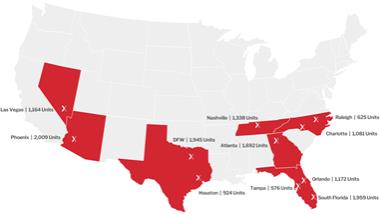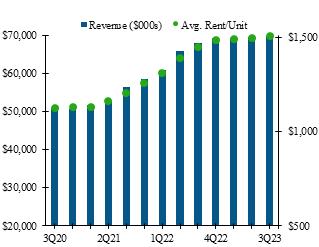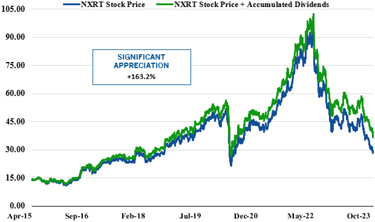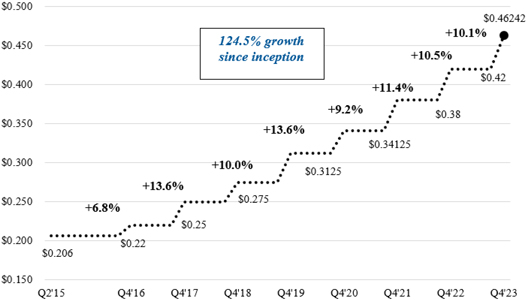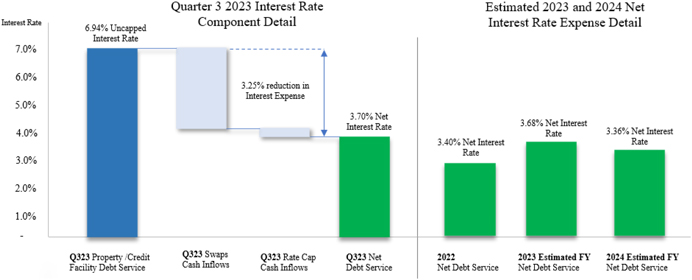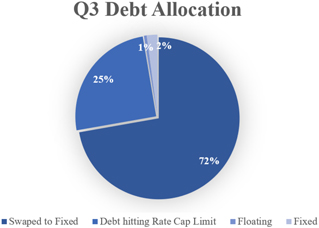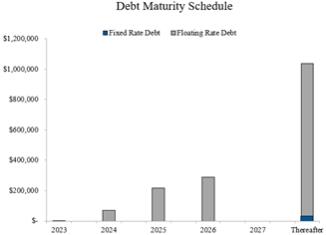NEXPOINT RESIDENTIAL TRUST, INC. [NYSE:NXRT]
Definitions and Reconciliations of Non-GAAP Measures
Definitions
This presentation contains non-GAAP financial measures. A “non-GAAP financial measure” is defined as a numerical measure of a company’s financial performance that excludes or includes amounts so as to be different than the most directly comparable measure calculated and presented in accordance with GAAP in the statements of income, balance sheets or statements of cash flows of the Company. The non-GAAP financial measures used within this presentation are net operating income (“NOI”), funds from operations attributable to common stockholders (“FFO”), FFO per diluted share, Core FFO, Core FFO per diluted share, adjusted FFO (“AFFO”), AFFO per diluted share and net debt.
NOI is used by investors and our management to evaluate and compare the performance of our properties to other comparable properties, to determine trends in earnings and to compute the fair value of our properties. NOI is calculated by adjusting net income (loss) to add back (1) interest expense (2) advisory and administrative fees, (3) the impact of depreciation and amortization expenses, (4) corporate general and administrative expenses, (5) other gains and losses that are specific to us including gain (loss) on extinguishment of debt and modification costs, (6) casualty-related expenses/(recoveries) and casualty gains (losses), (7) gain on forfeited deposits, (8) equity in earnings from affiliate, (9) property general and administrative expenses that are not reflective of the continuing operations of the properties or are incurred on behalf of the Company at the property for expenses such as legal, professional, centralized leasing service and franchise tax fees and (10) gain on sales of real estate. We define “Same Store NOI” as NOI for our properties that are comparable between periods. We view Same Store NOI as an important measure of the operating performance of our properties because it allows us to compare operating results of properties owned for the entirety of the current and comparable periods and therefore eliminates variations caused by acquisitions or dispositions during the periods.
FFO is defined by the National Association of Real Estate Investment Trusts (“NAREIT”), as net income (loss) computed in accordance with GAAP, excluding gains or losses from real estate dispositions, if applicable, plus real estate depreciation and amortization. We compute FFO in accordance with NAREIT’s definition. Our presentation differs slightly in that we begin with net income (loss) before adjusting for amounts attributable to redeemable noncontrolling interests in the OP and we show the amount attributable to such noncontrolling interests as an adjustment to arrive at FFO attributable to common stockholders.
Core FFO makes certain adjustments to FFO, which are either not likely to occur on a regular basis or are otherwise not representative of the ongoing operating performance of our Portfolio. Core FFO adjusts FFO to remove items such as gain on extinguishment of debt and modification costs, casualty-related expenses/and recoveries and gains (losses), gain on forfeited deposits, the amortization of deferred financing costs incurred in connection with obtaining short-term debt financing and the noncontrolling interests (as described above) related to these items.
AFFO makes certain adjustments to Core FFO. There is no industry standard definition of AFFO and practice is divergent across the industry. AFFO adjusts Core FFO to remove items such as equity-based compensation expense and the amortization of deferred financing costs incurred in connection with obtaining long-term debt financing and the noncontrolling interests related to these items.
Net debt is calculated by subtracting cash and cash equivalents and restricted cash held for value-add upgrades and green improvements from total debt outstanding.
We believe that the use of NOI, FFO, Core FFO, AFFO and net debt, combined with the required GAAP presentations, improves the understanding of operating results and debt levels of real estate investment trusts (“REITs”) among investors and makes comparisons of operating results and debt levels among such companies more meaningful. While NOI, FFO, Core FFO, AFFO and net debt are relevant and widely used measures of operating performance and debt levels of REITs, they do not represent cash flows from operations, net income (loss) or total debt as defined by GAAP and should not be considered an alternative to those measures in evaluating our liquidity, operating performance and debt levels. NOI, FFO, Core FFO and AFFO do not purport to be indicative of cash available to fund our future cash requirements. We present net debt because we believe it provides our investors a better understanding of our leverage ratio. Net debt should not be considered an alternative to total debt, as we may not always be able to use our available cash to repay debt. Our computation of NOI, FFO, Core FFO, AFFO and net debt may not be comparable to NOI, FFO, Core FFO, AFFO and net debt reported by other REITs. For a more complete discussion of NOI, FFO, Core FFO and AFFO, see our most recent Annual Report on Form 10-K and our other filings with the SEC.
| | | | |
| NXRT.NEXPOINT.COM | | Page 30 | | |





